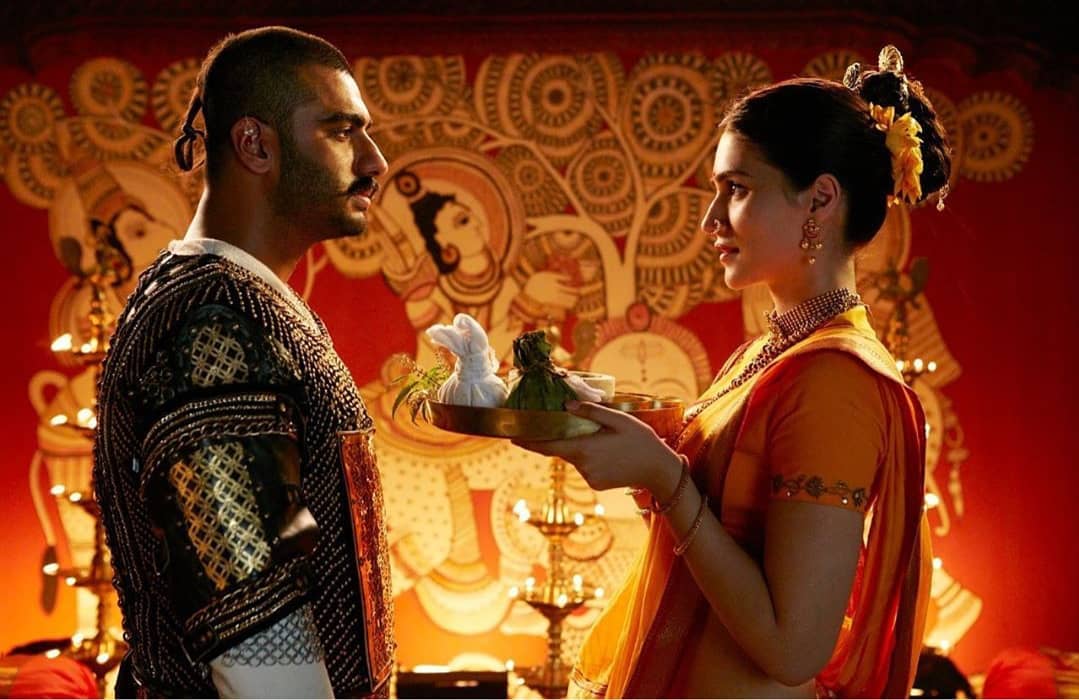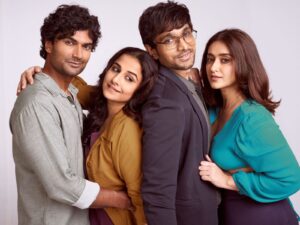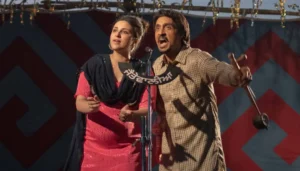
I never understood why people hail Ashutosh Gowariker as the pioneer of war films. Jodhaa Akbar worked more as a sublime romance despite its brief war portions. Lagaan and Khelen Hum Jee Jaan Sey had broader canvasses. I would rather call him as someone who could examine his characters’ emotional cores – at least in his more illustrious films. Be it a sports film, a patriotic docu-drama or a historical romance, his over-the-top characters more often than not gleamed with subtexts and thought worthy characteristics which made us forgive him for the respective films’ long runtime. In his latest period magnum opus Panipat, what we miss are human beings with real conflicts and ambitions. One that chronicles the destructive Third Battle of Panipat, Gowariker’s screenplay is one that merely skims the surface of its components while also glorifying several of its elements as if to appease the present political climate.
Appearing in almost every frame of the film from start to end is Sadashiv Rao Bhau (Arjun Kapoor). The film acts more like a biopic of the character rather than one that delves deep into the said battle. In fact, the war portions come to fore only in the last 20 minutes of the film which runs close to three hours. Panipat gives us a look into Sadashiv’s nobility, composure and adroitness as a warrior. In the more interesting segments of the screenplay in the otherwise drab first half, we see Gopikabai (an efficient Padmini Kolhapure) playing her share of politics to ensure the throne for her eldest son Vishwasrao. Other internal conflicts in the family are also faintly addressed but the half-heartedness is clearly visible. Was it the makers’ inability to research or their plain attempt to not hurt the Maratha sentiments? I am not sure.
One impressive bit in Panipat, I must add, is how it lends ample agency to its leading lady – as is the case with all of Gowariker’s films. Kriti Sanon’s Parvatibai is not relegated to the backseat as the categorical supportive wife. She is a part of the strategy and is also the film’s narrator – which is unusual for a film smeared with oodles of testosterone. That said, the worrisome part is how goody-goody her character is and ditto for the rest of the Marathas. Everyone else is either grey or jet black. The Hindu and Sikh rulers with whom Sadashiv tries to ally with are kind and easily complying to protect the honour of Hindustan. Their Muslim counterparts, on the other hand, are either skeptic, vile or are sheer betrayers. One of the few exceptions is Sakina Begum (Zeenat Aman, wooden as ever) who agrees to send supplies and her troop after Parvatibai convinces her in a brief emotional scene. The good Muslim stereotype does not end there. Ibrahim Khan Gardi (Nawab Shah, well-cast), the trusted general in Maratha army, is often looked down upon by the Maratha family members as they call him names such as gaddaar (I don’t know if such vocabulary even existed in that era). There is also Shamsher Bahadur, son of Mastani and Bajirao II, as one of the princes fighting the war and he seems to be following a Muslim way of life, complete with the characteristic beard and a lehenga-clad wife.
Rest of the Muslim characters in Panipat form the key antagonists and they are scheming to the hilt. Kunal Kapoor’s Shuja-ud-Daula and Mantra’s Najib-Ud-Daula are the cardboard villains in this heavily expository film which has only one colour in the story to paint them by. The portrayal of Ahmad Shah Abdali (Sanjay Dutt) is equally questionable even though it does not go to the extent of Padmaavat’s inhuman way of caricaturizing Alaudin Khilji. At least, Abdali is spared from looking like a barbaric womanizer. The Afghan invader is seen as a cruel person, which perhaps works for a story like this. He and his troops parade in heavy, fancy fur coats (I understand the weather in his empire but they are just too trendy in an evil sort of way). They eat a lot of meat. You see roasted chicken all over Abdali’s dim-lit palace as the film introduces him. It’s as if being non-vegetarian is an instant token to tell people that a man is malevolent.
Talking about characterizations, I could compare Sanjay Dutt’s Abdali to a forever embittered yet somewhere kind school principal. One who blindly believes in his favourite students and sets out to punish others only on the basis of hearsay. He also beats up children who bunk classes and send them right back to their classes. The man drops everything else and leaves to safeguard the class that he is the class teacher of. And lastly, he writes a letter of appreciation to a student’s parent after he/she exhibits all-round excellence despite constant negligence from his team of teachers. All these unintentional funny shades to such a villainous character coupled with Dutt’s thick Bandra-accented Urdu render Abdali a lot less terrifying.
The film, playing on safe tangents, works around a lot with colours to depict bravado and villainy. Sadashiv is forever dressed in the whitest of shades whereas his associates are seen in slightly darker off-white colours. The greyer the part gets, the clothing turn brighter and eventually turn ash, deep blue and pitch black. The saffron flag of the Maratha kingdom is always heralded amid bright sunshine with greenery (symbolizing harmony and abundance) around whereas the black flag of the Durrani Empire is seen flying in grim lighting, signaling bareness and a lack of sensitivity. C. K. Muraleedharan, the DOP, knows his job for sure but the poor CGI fails his craft big time. However, I liked the way he and Gowariker keeps the opulence on check unlike a Bhansali fare where the dressiness often topples the film’s subject matter. This is not to say that the film scores big on its written material either. It doesn’t.
It wasn’t a surprise by any measures but I simply couldn’t buy the need for the screenplay to be so one-sided. Agreed that it is narrated from the perspective of Parvatibai, the wife of Sadashiv Rao, but the abysmal war strategy of Marathas never stands addressed. Panipat believes is putting the entire blame on other parties. How about humanizing the Maratha warriors as people of real flesh and blood with actual emotions running in their minds? Gowariker and his team writers have no such ambitions. Then comes the additional angle of glorifying them to godly proportions throughout the film’s unbearable runtime.
To give the film some credit, I can note how Panipat is well-meaning in certain ways. It doesn’t overtly push the Hindutva message like certain films from the recent past. Nor does it come with fight scenes that look shamefully contemporary. The actors look realistic by physique and the action choreography is rousing if we ignore the occasionally irksome VFX. The strategy during the war sequence comes of as one that feels real unlike, say, the recent Manikarnika which made a joke out of Rani Laxmi Bai’s warfare. Ajay-Atul’s music and background are earthy with a delightful Marathi flavour as both ‘Mard Maratha’ and ‘Sapna Hai Sach Hai’ turn out to be solid, atmospheric compositions. The third song (‘Mere Mann Mein Shiva’) where the royals put up a choreographed performance is unnecessary as if it belongs to a different film altogether. The production design (Nitin Chandrakant Desai) and costume (Neeta Lulla) departments do not goof up unlike Gowariker’s previous fare, Mohenjo Daro. The dialogues (Ashok Chakradhar), sprinkled with an ample dose of Marathi, are excellent even though their renditions do not do them any justice. While I do complain about the film’s length, it can hardly be attributed to the editor Steven Bernand’s frame selection skills – which keeps the narrative smooth, engaging and visually appealing. I particularly appreciate the scene by the banks of Yamuna where Sadashiv and Abdali look at each other via binoculars. They communicate without exchanging a word, with the turbulent river forming a violent metaphor. A glimpse of Gowariker’s mastery that we always admired, may I add?
Performances are a mixed bag in Panipat. Shouldering the maha responsibility of a project as gargantuan as this, Arjun Kapoor is earnest. In fact, he is so earnest and excited to not let things go wrong that the fear and strain are evident in his body language. While I agree that the actor’s dialogue delivery has improved by leaps and bounds, he has a long way to go until he turns into an uninhibited performer – which is a pre-requisite for a part as Sadashiv Rao’s. Kriti Sanon bags a meaty part and, to my surprise, she does a striking job despite tints of contemporariness popping out in between. The actor expresses herself beautifully in the emotional scenes and her sole action scene is crackling. As stated before, Sanjay Dutt is so dull and disinterested that I could barely remain invested in Abdali’s spitefulness. Mantra bags an important part in which he looks and performs with decent understanding of the material. It was also heartening to spot Mohnish Bahl as Peshwa Nanasaheb and he expectedly does a swell job.
As Panipat ends, its one-dimensional and largely distant storytelling keeps you unaffected. The film wants us to feel patriotic and appreciate the valour of Sadashiv Rao Bhau, his warfare and his marvelous administrative skills. It could all have happened if the film were to delve deeper into his psyche and also of the antagonists’. I could never become actively invested in Sadashiv’s journey and that wasn’t the case with those of Bhuvan’s (Lagaan) and Mohan’s (Swades). So yes, if you want a visual and deviously tweaked version of the Wikipedia entry of the Third Battle of Panipat, Gowariker’s film will suffice your curiosity. Otherwise, the film’s lack of depth will leave you craving for the filmmaker’s golden days in the 2000s.
Rating: ★★ 1/2
Panipat is now streaming on Netflix.


To be honest, after watching the trailer, I was never convinced by the chosen cast of the movie. But since it was coming from Asutosh Gowariker, I still kept hopes. But was terribly disappointed last evening.